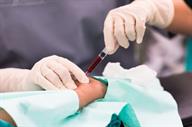Arterial Blood Gases Test
Why am I having this test?
Arterial blood gases (ABG) testing measures the amount of oxygen and carbon dioxide in your blood. Oxygen and carbon dioxide are known as gases. This test also shows whether your blood pH is balanced. Blood pH balance means that your blood is not too acidic (acidosis) and not too alkaline (alkalosis).
This test is commonly used if you have difficulty breathing. You may also need this test if you have:
What is being tested?
The test may include measurements of the following:
pH. The pH level indicates the acid–base balance of your blood. Your body needs a balanced pH to be healthy.
Partial pressure of carbon dioxide. This is the amount of carbon dioxide gas that is dissolved in your blood. Carbon dioxide gets removed from your blood when you breathe out. This helps to keep the pH balanced.
Bicarbonate. This is another way to keep the pH balanced by the kidneys adding a base to your blood.
Partial pressure of oxygen. This is the amount of oxygen gas that is dissolved in the blood. Oxygen enters your bloodstream when you breathe in.
Oxygen saturation. This is the percentage of hemoglobin oxygen saturation. This refers to how much oxygen is bound to hemoglobin and can be used by your body.
What kind of sample is taken?

An arterial blood sample is required for this test. It is usually collected by inserting a needle into an artery in your wrist, arm, or groin. The blood draw is more painful than a traditional blood draw (venipuncture). The health care provider will hold pressure on the site for several minutes after the procedure.
Generally, this is a safe procedure. In rare cases, however, problems may occur, including:
Tell a health care provider about:
-
A dialysis fistula, if you have one.
-
Any blood thinning medicines, if you take some.
How are the results reported?
Your test results will be reported as values. Your health care provider will compare your results to normal ranges that were established after testing a large group of people (
reference ranges). Reference ranges may vary among labs and hospitals. For this test, common normal reference ranges are:
- pH
- Partial pressure of carbon dioxide (PaCO2)
- Partial pressure of oxygen (PaO2)
- Bicarbonate (HCO3-)
- Oxygen (O2) saturation
Adult or child: 95–100%.
Elderly: 95%.
Newborn: 40–90%.
What do the results mean?
Acid–base balance is very important. Even small changes can cause dangerous effects.
A pH level above the reference range (
alkalosis) may be caused by:
Breathing too fast (hyperventilation).
Low potassium (hypokalemia).
Vomiting.
Medicines such as diuretics.
A pH level below the reference range (
acidosis) may be caused by:
Talk with your health care provider about what your results mean.
Questions to ask your health care provider
Ask your health care provider, or the department that is doing the test:
When will my results be ready?
How will I get my results?
What other tests do I need?
What are my next steps?
Summary
-
Arterial blood gases (ABG) testing is done to measure the amount of oxygen and carbon dioxide in your blood.
-
This test also shows whether your blood pH is balanced. Blood pH balance means that your blood is not too acidic (acidosis) and not too alkaline (alkalosis).
-
An arterial blood sample is required for this test. It is usually collected by inserting a needle into an artery in your wrist, arm, or groin.
-
A blood pH imbalance may indicate a number of conditions. Talk with your health care provider about what your results mean.
This information is not intended to replace advice given to you by your health care provider. Make sure you discuss any questions you have with your health care provider.
